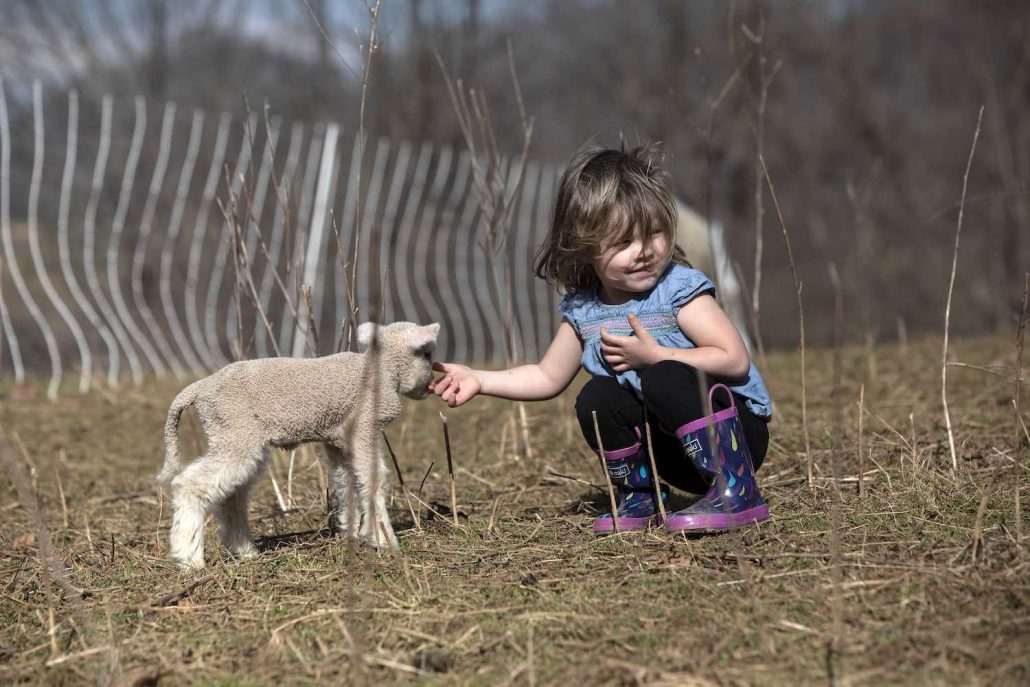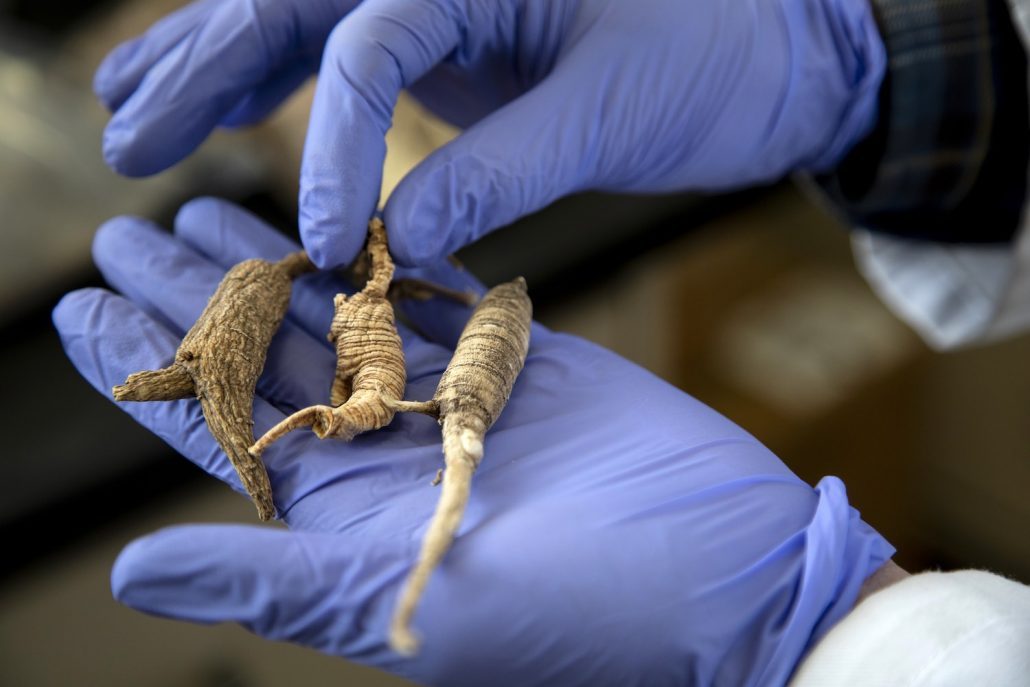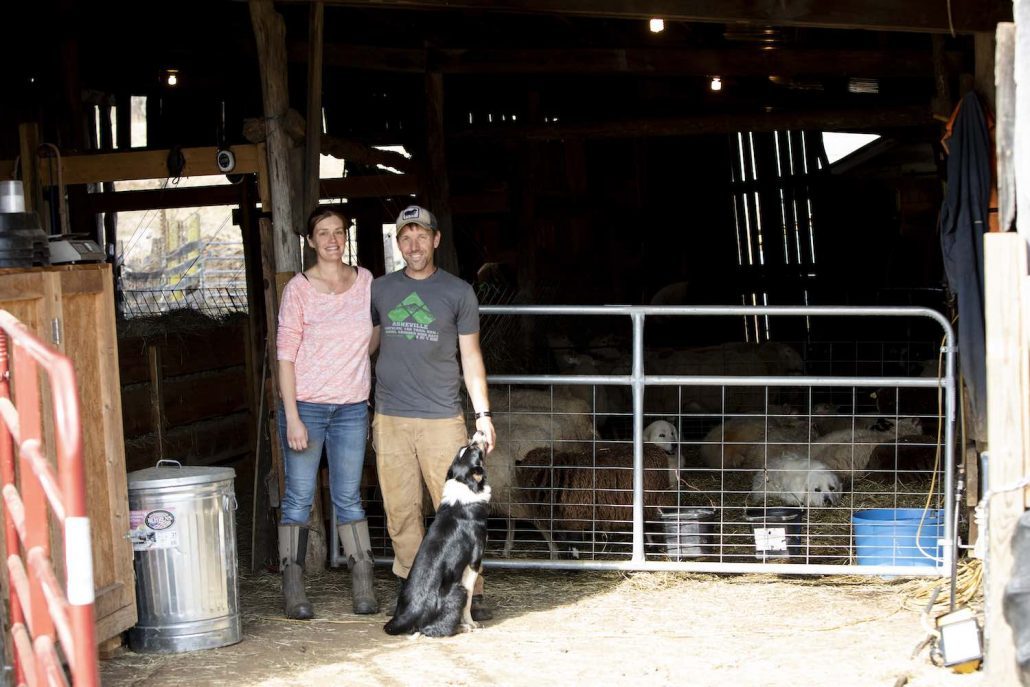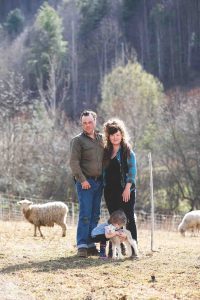Finding A Way
How modern farmers are open-sourcing the future of food
BY MEREDITH LEIGH | PHOTOS BY ERIN ADAMS
“We didn’t even own a shovel.” This is what Sharon Dubuc told me as she walked me through her pastures toward the sheep she and her husband raise at Black Thorn Farm & Kitchen in Sandy Mush, North Carolina. We hiked using fence posts for walking sticks, she had her baby, Magnolia, strapped to her chest and her boots laced high and tight, and it occurred to me that she was attempting to tell me about how crazy she and Seth must be to consider themselves farmers.
The first pasture was lush, a surprise so late in the season. We looked at the plants growing there—dense clovers and cool fescues, deep-rooted docks, and early invasive weeds. “When we moved here, the land was so open. Too open. All the trees you see—we’ve planted them. And the soil here, these plants, they’re figuring something out. We’ll have to see,” Sharon told me.
I asked her how she knew to get sheep, and how she knew where to plant persimmons, cedars, pawpaw trees.
“We didn’t, really. We just knew how we wanted the land to feel, and we looked at the hills and the unsheltered space, and it just sort of made sense.”
Her sheep were downy and winter-ready, gathered up under a grove of trees. We stood away from them so as not to bother them, though Sharon wanted to get into their huddle, to look at their thick bodies, their eyes, and their teeth.
“We just read a lot. We read Stockman Grass Farmer. We read Joel Salatin. We learned, and are still learning, from our neighbor down the road. He’s had sheep forever.”
I said, “Yeah. Almost nobody we can read raises wool sheep on grass in the mountains of North Carolina, though.”
We agreed. We spent the next half hour chewing the fat about stocking density, intestinal roundworms, lambing cycles, shearing, and other farmer shoptalk. About how beginning lambing 30 days sooner could make or break the season, could allow a different paddock arrangement, could scare a farmer out of business. How a 30-day delay in lambing could mean an extra heavyweight ram for next year, a healthier stand of grass, a new way forward.
But who’s to know?
We tend to think of farmers as one type of person, coming from other farmer stock. Sure, there are farmers who have been land tenders forever, who have inherited land and learned the ways of it from family elders. But there is a rising tide of farmers who are new to the calling, having joined the mass exodus of people from cities and corporate jobs to a quiet life of more autonomy.
I count myself among those types of farmers, a city girl who found herself in wide open pastures and wrist-deep in soil. This cohort of land tenders are of all kinds: corporate IT managers, hedge fund investors, laboratory scientists, and college dropouts. Together, they’re working on an entirely new agriculture, a version of what they believe food should be. And as they grade and sow, reap and water, they also shape what they feel the land should be, and where this food they believe in should come from.

Magnolia Dubuc adds her love to the care of the sheep.
—
Before he bought a farm, Rolando Boye spent twenty years thinking, considering, and analyzing herbs and herbal supplements as a manager at the US Botanical Safety Laboratory, a testing facility for natural product ingredients. He specializes in quality assurance and herbal product standards, a job that grew from his interest in natural medicine, permaculture, and earth skills.
“At first, the easy option was manufacturing and wholesale quality control, but not the earth,” he told me.
Eventually, years of lab work, industry lingo, and chemistry led him to his calling. “Truly, I’m a medicine maker,” he said definitively. We sat at his kitchen table, accompanied on and off by his wife, Kristen, whose family is also in the supplements industry. They spoke of the declining quality of herbs on the market, heavy metals, and soil pollution. “My motivation is to produce better products using approaches to soil health, to see if an ecological approach will elevate medicinal phytochemicals in the plants,” Boye said. “If I don’t do this, I might die wondering about it.”

I recognized this hunger immediately, the type that comes from inside of the status quo. Working in the world at large can expose the shortcomings of human-made systems, and there are many farmers of the new order who have entered into their profession out of a dissatisfaction with the overarching example, and a deep yearning to prove a better way. Call it a hunch, inspired by nature, that drives a personal and professional life-way, even if the challenges to such a dramatic shift are substantial.
“The pull in my heart is overriding the mental aspect,” he said. “There’s so much. Some days I see it so clearly. Some days I wonder if it’s even worth it.”
Boye has just settled in Asheville and just purchased land for his farm. Their family holding is small, in part by design, and in part because of the limitations on land access due to high market prices in the area. Additionally, the decline of community in rural places leaves little option for young families. Schools, day care, libraries, and even playmates can be limited. Ultimately, Boye is happy with his setup, which is a relatively small two acres in Riceville, with indoor space for herbal products processing. He walked me out into the unplanted field, painting pictures of 10-year perennials, mushrooms, tea plants, and specialty herbs. His excitement was infectious, endearing.
I asked him if he worries about the success of the business, or the realities of launching a niche medicine company in a wider world where supplements are losing credibility and consistency.
“I’ve always said, ‘Go in not blind,’ and I think I’ve done that so far,” he said. He’s read widely the books from others in the niche supplement industry, including farmers of vegetables and fruit. He is a graduate of the local Farm Beginnings program, offered by Organic Growers School, a local nonprofit. “That program gave me a realistic idea of what I’m getting into,” he said, and allowed him to “marry economics with earth skills.”
Indeed, many farmers are pulled into their work by the power of intuition and idea, but the business side of things tends to come second. Programs like Farm Beginnings, the Appalachian Resource Conservation and Development (RC&D) Field School in Johnson City, and programs available through Appalachian Sustainable Agriculture Project (ASAP) and Farm Credit have been developed to address business and financial literacy in the small farming sector.
Warren Wilson College offers one of the most unique sustainable agriculture education programs in the country, with a combination of science-based academics and field work on the college farm. Mary Bulan is lead faculty in the agriculture program there, and says, “Almost none of the students come from traditional farm backgrounds.” Most of her students don’t even know they’re interested in farming when they first attend the college, but “something about the work appeals to them and the way they want to express their values,” she says. While the program doesn’t include rigorous business training, it does “get their foot in the door,” according to Bulan. “I think young farmers are savvy about how difficult it is to make money as a production farmer, and my hope is that our pro- gram gives them a really solid idea of their economic niche.”
—
Andrea Van Gunst and Tim Gallagher of Grassroots Farm & Dairy know the economic uphill of small-scale farming all too well. I’ve watched their farm journey since the beginning, as they moved from leased parcel to leased parcel, trying to find their footing. They started out with vegetables almost ten years ago and now find themselves fully capitalizing what might be North Carolina’s first and only Grade A sheep dairy. I arrived on shearing day, and found Andrea and one-month-old baby Willa behind a mountain of wool, picking it free of manure and briar, hemmed in and focused under steep hills so close that they cut into the sky. This image alone seemed to capture the essence of the story: slow farming, by hand, babe in tow.
“After moving around so much those first few years, the most memorable thing for me was standing in that janky barn with its busted windows when we first bought this property, and the frogs were so loud they were all you could hear,” Andrea said. She and Tim lived in that barn with their son before restoring a house by the road that was condemned. Now, the barn is being converted to a creamery. As I walked through the small rooms, for milking, pasteurizing, and yogurt-making, I could see the pencil lines on the walls from where they laid out the lighting and the stud frames, a literal map of the handmade journey of the place.
I managed to wrestle Tim away from shearing to talk by the creek. A common theme is not to quit one’s day job, so Tim works as a web developer as well as a farmer, as well as a dad to two kids.
“Tim works really hard,” Andrea tells me. “I think that’s so important to note. I haven’t been able to be as hands-on, since we have young kids, so he’s working nonstop to keep everything running.” Tim’s most vivid memory was Andrea going into labor with their first child, Henry, and having to go herd the sheep into the barn before leaving for the hospital. “It was dawn,” he remembered. “It was so raw and so beautiful and so intense.”
“I think the most important thing about it is that we have gone really slow, we’ve always been hyper financially conservative, and we’ve always focused on quality of life,” he said. I remarked how interesting it is that they happen to be building what is probably one of the most expensive business models in modern farming. We all laughed about it, and they shared that while they have read all the books and been to all the local conferences, their biggest learning has happened by finding dedicated mentors in sheep farmers around the country, some of whom they aren’t afraid to call at 3 a.m.
In this way, I am reminded that this truly grassroots movement toward better farming is one of the most open-sourced in modern business. Farmers share by way of blogs, books, conferences, and even organized networks, where they tour each other’s properties, create mingling opportunities for their workers, and drink beers together sitting on upturned crates by the barn door. And in this way, the future of food is being built simply, by these people who are going at it question by question, day by day. “You cannot be afraid to ask for help,” Andrea remarked. “We’ve gotten some bad info from other people, too, you know? So it’s slow going. You find out.”

Andrea Van Gunst and Tim Gallagher of Grassroots Farm & Dairy have relied on mentors as they launched their sheep dairy.
After six years building their flock, their family, and their business, she feels they are just now hitting their stride. “I’m excited because now we have the right number of sheep, and we can start creating efficiencies, and testing the business. It might take five more years before we know whether it will work.”
“That’s right,” Tim agreed. “I mean, in theory, we can raise sheep how we want to, in good balance with nature, and we can produce great quality products, and we can make a living.”
Jury is still out, in other words. I wonder, is it enough? Is there time? Are there enough willing people to pencil out conduit lines on the janky barn walls, live with their toddler in a tent, or work two day jobs while they financially and emotionally bolster a very important question about food and land?
“Farming is a really great career, and really important,” Mary Bulan of Warren Wilson says. “I think we have to do whatever we can to get people into it and to keep them thriving.”
For now, there are 10-year-old persimmon trees in Sandy Mush that Sharon and Seth Dubuc planted, and the steep hillsides under sheep’s hooves in Marshall aren’t eroding. Rolando Boye is falling asleep every night with something good to dream about. Henry and Willa and Magnolia, and all the other children, are climbing in and out of brooks and streams and getting their knees dirty. And per- haps, if there is a memory of land and a record of someone’s powerful hunch stored in old barns or notebooks, this effort will continue to be held in the hands of regular people who will find a way. ◊◊
Meredith Leigh is the author of The Ethical Meat Handbook: A Complete Guide to Home Butchery, Charcuterie, and Cooking for the Conscious Omnivore (3rd place, MFK Fisher Award 2015) and Pure Charcuterie: The Craft & Poetry of Curing Meats at Home. Meredith works part time for Living Web Farms, and she travels extensively teaching charcuterie and food production and processing. She also pursues other writing, namely poetry and nonfiction focused on the intersection of land and people, and land and the culinary sphere, with work featured in Crop Stories, various Edible publications, and Mother Earth News Magazine, among others. She lives with her partner and four children in Asheville, NC.
Save
Save
Save
Save
Save
Save
Save
Save
Save
Save

With daughter Magnolia, Seth and Sharon Duboc raise sheep at Black Thorn Farm & Kitchen in Sandy Mush, North Carolina

Rolando Boye has just settled in Asheville and purchased land for his farm.
THE WEEKLY REVEL
Sign up for your free handpicked guide to enjoying life around Asheville.
Available weekly from May to October.





